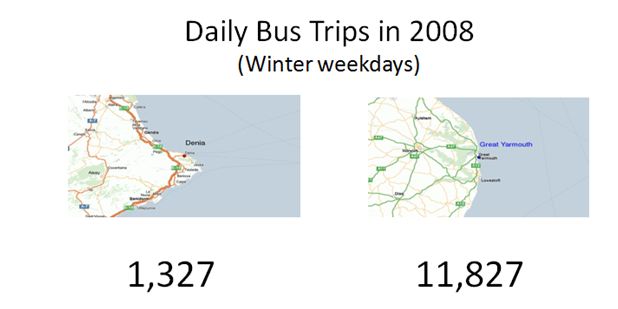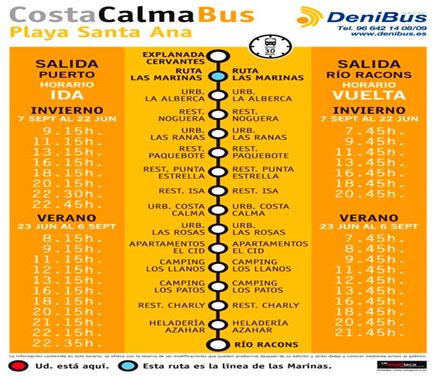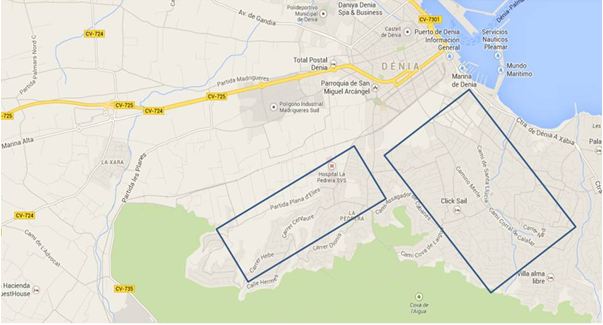There is a good deal of talk about the environment and sustainable transport, but what does this mean in practice? In brief, I would suggest that it means encouraging people to use their cars less and to provide a higher quality level of public transport. In theory, such a move would reduce emissions and reduce town centre congestion, both laudable aims in themselves.
To see how these concepts translate in practical terms, this post examines two towns. Great Yarmouth (GY) is in East Anglia in the UK and Denia is at the northern tip of the Costa Blanca in Spain. In 2010, their populations were very similar, with Denia at 44,500 and GY at 47,200. Both towns have a significant influx of tourists in the summer season.
Figure 1: Daily Bus Trips in Denia and Great Yarmouth
From this graphic, it is evident that bus usage in Great Yarmouth was nine times as high as in Denia. There is in fact an updated version of this plan (from July 2012), but it is clear that the text from the earlier 2008 document has just been copied and pasted (incorrect bus routes, identical passenger volumes, etc.)
Over the period, car ownership increased in GY but declined in Denia by a quite hefty 10%.
This post examines the reasons why usage of public transport is so poor compared to a similar-sized UK town.
The provision of information is poor in Denia. In Figure 2 below, we can see the departure times of the service at the beginning of the route but no intermediate times. Also, the bus company provides no sensible information on the location of stops; where, for example is “Urb(anización) Las Rosas?
Figure 2: Typical route map of a local bus in Denia
By contrast, the town of Elche, at the southern end of Alicante province, shows the stops for all routes overlaid onto a map (see Figure 3). The website allows any number of routes to be selected and the map itself to be magnified or moved, as required by the user.
Figure 3: Typical route map of a local bus in Elche
There are two likely reasons for poor use of public transport in Denia. First, consider figure 4 below which shows where the transport facilities are located in the town.
Figure 4: Dispersed Transport Hubs in Denia
The railway station provides an hourly tram service to Benidorm operated by Alicante Tram via the coastal towns of the northern Costa Blanca and the bus station serves as a calling point for long distance coach services and a terminus for services to Javea, inland towns and the Ondara shopping centre.
There are three local bus services in operation. Two services run along the coast roads and terminate at the port and do not enter the town at all. The third runs between the local bus terminus and the hospital which opened in February 2009. This service runs along the main road (Avenida de Valencia and Alicante) and passes the bus and railway stations, but this coincidence is most likely due to taking the shortest route between the local bus terminus and the hospital rather than any attempt to co-ordinate between the different modes of transport.
Denia hosts a large weekly market on Mondays, on the site of a 2,000 space car park and the courthouse is also in the same area. However, the closest local bus stop for the market is the terminus, which is 1.4 km away; this is hardly conducive to encouraging market visitors to use public transport. Similarly, passengers arriving on medium and long haul buses at the bus station have a 1 km walk to reach the local buses.
In addition, there are large parts of the town, within 5 km of the town centre, which have no bus service whatsoever. The areas covered by the blue rectangles in figure 5 below have no local service whatsoever, even though the company operating local bus services has recently purchased minibuses which could partially penetrate these areas.
Figure 5: Selected Areas of Denia without Bus Service
Going back to our original comparison, we can see that Great Yarmouth has a much wider choice of routes. Figure 6 shows the number of weekday services in each town.
Figure 6: Supply of Bus Services in Denia and Great Yarmouth
The largest failing on the part of public transportation in the Denia area is institutional. Local buses, the train/tram, medium and long distance operations are each handled by different companies. Whilst this is not in itself a problem – in Britain, all public transport outside London is in the hands of various private operators – the refusal of each operator in Denia to acknowledge the existence of the others, let alone co-operate with them, makes travel by more than one mode seriously inconvenient. There are no joint tickets, nor any co-ordination of routes or timetables.
There are also legal constraints in providing a bus service which meets the requirements of the population that it is meant to serve. First, a local bus service running between Ondara, the large shopping centre within Ondara’s municipal boundaries, the hospital and the town centre would be ideal, as it has two major “attractors” on the route. However, because of the municipal boundary issue, this service does not exist.
Perhaps the most egregious example is the service between Denia and Javea, a town of some 33,000 people and the second largest town (after Denia) in the Marina Alta. Depending on the route that a bus would take, the distance between the two towns in between 15km and 24km. Although local buses within the two towns are operated by one company (Denia Bus) the route connecting them is operated by Autobuses Carríl. There are seven buses each way on weekdays and none whatsoever at weekends. Although the inter city bus company (ALSA) operates between these two towns several times a day, they are not allowed to transport passengers between Denia and Javea, even when the Carríl service is not functioning.
The original 2008 study acknowledged all these failings. However, in the last five years since the report was done, absolutely nothing has been done to rectify the shortcomings of Denia’s public transport “system”. Money is a minor issue here: it is much more to do with being accountable and responding to the public that the authorities were elected to serve.







